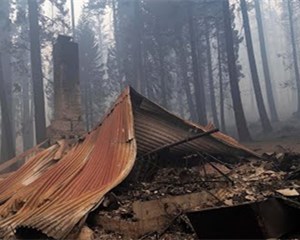JUDY WOODRUFF: Back in this country, firefighters in Northern California made more progress today against the massive Caldor Fire raging near the Lake Tahoe resort area. The flames are now 20 percent contained, after burning more than 204,000 acres since mid-August. Stephanie Sy has the latest.
STEPHANIE SY: Plumes of black smoke rose above the historic Echo Summit mountain pass early this morning, signs that the Caldor Fire is creeping closer to South Lake Tahoe, the most populous city on the lake. Nearly 4,000 firefighters battling the raging inferno made some progress today. The fire has already destroyed hundreds of structures.
KEITH WADE, Caldor Fire Incident Command: We have been resource-starved here at times. We're continuing to get more people sent to us, but it's still not enough, as this fire is shown to be a huge challenge for everyone involved. Fuel load is extreme out in these areas. Everything is easily ignitable. And the vegetation is very thick and dense and the areas are sometimes inaccessible.
STEPHANIE SY: Thousands of members of California's National Guard have also been deployed to assist with the fire response and evacuations. For days, erratic winds and low humidity have spread spot fires, with embers flying and spreading the flames.
STEVE VOLLMER, Fire Behavior Analyst: Those ember casts that it throws out are going over a mile in distance. So that's what's propagating the spread of the fire right now, is that long-range downwind spotting of that ember cast.
STEPHANIE SY: And the thick smoke has made it difficult for crews to navigate the rough terrain. On Monday, some 50,000 people in the popular resort region were placed under evacuation orders, snarling traffic for hours. A tourist area that's usually filled with thousands of holiday visitors is now almost empty. Military vehicles, fire crew personnel, and an odd bear were seen in the city's smoke-filled streets. Only a few residents remain.

DAVID DUET, South Lake Tahoe Resident: No one's stupid enough to stay when the flames are right mounting around the outside of the meadow. So, as long as the smoke isn't so bad and the flames aren't real close, we're going to stick it out, you know? But, if not, we will hightail it out.
STEPHANIE SY: Evacuation orders have also expanded to communities in neighboring Nevada, along the California state line. Meanwhile, the massive Dixie Fire is also still burning through the Sierra Nevada. It's the second largest wildfire in the state's history, and has burned over 844,000 acres since it began in early July. Scientists say climate change has made worse the hot and dry weather conditions fueling the West's extreme wildfires. And it's also contributed to the warming of water, making hurricanes such as Ida in the Gulf Coast more dangerous. Katharine Hayhoe is a climate scientist and the chief scientist for the Nature Conservancy.
KATHARINE HAYHOE, Climate Scientist, Texas Tech University: Climate change didn't cause Hurricane Ida, but it definitely made it worse, and that's what climate change is, a threat multiplier. It's taking events that occur naturally and it's making them bigger, stronger, more dangerous and more damaging.
STEPHANIE SY: That includes wildfires.
KATHARINE HAYHOE: Imagine you had a green, wet wood, and you accidentally dropped a match into it. What would happen? Not much. Then imagine you had a pile of bone-dry kindling, and you accidentally dropped a match into it. What would happen? A huge conflagration. That's the difference between with or without climate change.
STEPHANIE SY: This year is on track to be California's worst fire season on record, and it's far from over. For the "PBS NewsHour," I'm Stephanie Sy.












